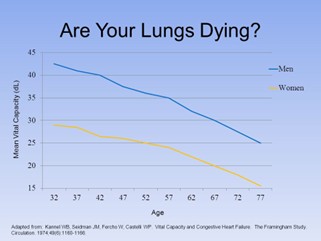| Reader, Your lung power typically decreases with age.
But it doesn't have to.
Throughout my career, I've helped my patients – and readers like you – retain and restore their lung power…  More than any other factor, your lungs will determine how long you will live. | Because more than any other factor, your lungs will determine how long you will live.1
For years, the only way to improve lung capacity was with exercises that challenged your lungs.
Today, I'll show you another way.
At the Sears Institute for Anti-Aging Medicine, I first determine lung age by measuring VO2 max levels.
Knowing this biomarker of aging not only tells me the biological age of your lungs, it also tells me how much oxygen you use when you exercise.
And how much lung power you have.
Lung power typically decreases with age. But it doesn't have to.
For example, a 60-year-old man with above-average lung power has "younger" lungs than his peers. The same man with a VO₂ max below his peers would have "older" lungs.
Recently though, scientists discovered that a popular herb called ashwagandha boosted VO2 max levels.2
It works in three key ways by increasing VO₂ max by: - Enhancing mitochondrial function. Ashwagandha improves the efficiency of energy (ATP) production in cells, especially in muscle tissue.
- Increasing hemoglobin and red blood cell count. This leads to better oxygen transport throughout the body.
- Reducing oxidative stress. The antioxidants in ashwagandha help protect tissues from damage during intense physical activity, preserving muscle and cardiovascular function.
Ashwagandha isn't new. This adaptogenic herb has been used in traditional Ayurvedic medicine for thousands of years.
Modern research supports its many benefits, which include: - Reduced stress and anxiety
- Improved cognitive function, memory, and mental clarity
- A good night's sleep
- Increased strength and muscle mass
- Better hormonal balance
- Enhanced heart health
- Balanced blood sugar
- Lower C-reactive protein, a measure of inflammation
- Stronger immunity
And now, we can add better lung health to this long and impressive list!
You see, this is the first time a nutrient increased a biomarker of lung power. And not just any biomarker, but the one that defines your lung age. How To Use Ashwagandha When buying ashwagandha supplements, avoid products that blend root, stem, leaves, and berries because it's impossible to get the dosage right when it's all mixed in together.
After all, different parts of the plant have different strengths.
Instead, I recommend taking a supplement capsule containing 150 mg to 300 mg of pure root extract twice a day.
Or you can buy dried ashwagandha root powder. Look for a product that's 100% organic with no artificial flavors or colors.
To make a serving of healing ashwagandha tea: - Boil one cup of water in a saucepan.
- Add one-quarter teaspoon of ashwagandha powder.
- Let the water boil for 10-15 minutes.
- Strain into a cup. Add some fresh lemon juice and a touch of organic honey to taste.
Start with a quarter teaspoon twice a day then gradually increase to one teaspoon twice a day.
I also recommend my patients take ashwagandha before doing their PACE workout as a way to protect, boost, and even restore lung power. To Your Good Health, 
Al Sears, MD, CNS
References: - Schünemann HJ, et al. "Pulmonary function is a long-term predictor of mortality in the general population." Chest. 2000;118:656-664.
- Choudhary B, et al. "Efficacy of ashwagandha (Withania somnifera [L.] Dunal) in improving cardiorespiratory endurance in healthy athletic adults." AYU. 2015;36(1):63-68.
|
No comments:
Post a Comment